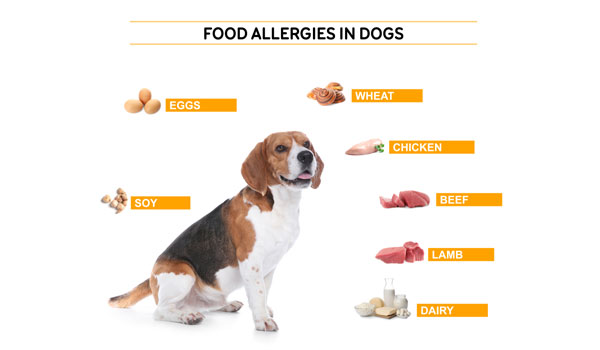
Dog food is one of the main reasons behind allergic reactions and conditions in dogs. Sadly, food allergies are often overlooked, with many pet owners instead choosing to attribute allergic reactions to environmental factors and pests such as fleas.

Whether food, pests, or environmental factors cause the allergy, the pet’s immune system reacts by producing antibodies and histamines that lead to some symptoms associated with these allergies.
Food allergies in dogs can range from mild to severe, and this is why it is so important for all dog owners to learn the associated signs, test for these allergies, and how they are treated.
Foods That Cause Allergies
The most common allergens for dogs include beef, chicken, dairy products, and eggs. These products are thought to be problematic for domesticated dogs due to their high protein content.
Because some plants and plant-based diets might also contain lots of proteins, they can also cause allergic reactions. Do note that they have to be exposed to a specific kind or brand of food for a dog to develop an allergy. This is why foods that contain proteins commonly found in dog food (beef and chicken) have more incidences listed.
Related Posts:
- How to Test Your Dog for Allergies
- 9 Most Common Dog Allergies: Symptoms and Treatment
- 7 Ways to Raise Your Dog Holistically
- Dog Allergies: Symptoms and Cures
- Tips And Tricks You Can Do Around The House To Limit Pet Allergies
Even when you eliminate these foods from your dog’s diet, it is important to remember that dogs that have an allergy are likely to have more than one.
Dogs that eat a lot of carbohydrates are usually at a lower risk of developing allergies.
This is because foods rich in carbohydrates and starches will usually have very little protein. Some exceptions to this rule include potatoes, wheat, and corn which contain proteins.
Other things to keep in mind include fish oil, which contains little protein, gelatine found in some capsules and which contains proteins, a peanut butter – although dogs are rarely allergic to this – and additives.
Additives like colorants, preservatives, flavorings, and other chemicals might not cause an allergic reaction but might lead to intolerance symptoms or adverse reactions.
dog food allergies symptoms
Fortunately, many of the symptoms of allergies and allergic reactions manifest physically, so they are easier to see.
Itchy skin is one of these common symptoms. Also known as allergic dermatitis, it can happen anywhere on your dog’s body, usually the head, stomach area, and neck.
Hives can also appear up to 24 hours after your pet eats something they are allergic to.
These hives are easier to see in dogs that have shorter fur, but you may have to feel for them otherwise.
Dogs with itchy skin or hives will often bite, scratch, or lick affected areas, so you might see broken skin, flattened fur, or areas where fur is missing.
If the skin breaks or tears, that may lead to an infection that might need treatment. There could also be temporary or permanent hair loss in the affected areas.
Food allergies can also cause chronic paw and ear infections. These are repeating or long-term infections that don’t respond to medication and might need drastic changes in food and the environment to see any relief.
Swelling of the face, usually the eyelids, ear flaps, and lips, indicates food allergies.
Another symptom to watch out for is gastrointestinal distress. This can present as gas, diarrhea, and vomiting. Gastrointestinal distress does not go away when you change environmental factors, and you have to change your pet’s diet to see any changes.
Additional symptoms can include secondary bacteria and yeast infections, itchy paws, sneezing, scaly skin, eye discharge, and red eyes.
Rarer dog food allergies symptoms
These symptoms are not as common as the ones discussed above, but all dog owners ought to know about them:
- Nasal discharge
- Weight loss resulting from vomiting and diarrhea
- Seizures in dogs predisposed to certain allergens
- Breathing issues
- Secondary urinary tract infections caused by the overgrowth of bacteria
Testing for Allergies
If you notice any of the symptoms listed above, it is always best to have your pet tested for allergies.
Dog allergy testing can help you find out which allergens are causing any of the symptoms listed above and are the first step in helping find relief and a solution for your dog. The main types of tests include:
- Testing for food allergies.
- Testing for allergic reactions caused by lice and other pests.
- Testing for environmental factors.
Testing for food allergies at home is inexpensive as you only have to buy the food you will be testing with.
Other types of allergy testing, especially those that test for fleas or environmental factors that may be causing allergic reactions, will require laboratory testing and a visit to a veterinarian.
Carrying out food allergy testing will usually involve getting your pet used to foods that have limited ingredients.
Because these types of food have up to 10 ingredients, they eliminate most of the ingredients you would find in other dog foods. They also do not have any additives or fillers.
Once you purchase a limited ingredient pet food, you should try to wean your pet off other foods until they only eat the new food.
You can then start reintroducing different foods in 1–2-week intervals to see if they are allergic to anything you include in their meals.
Once you identify an allergen, which will sadly be due to your pet reacting to a certain food, you can take it off the list and gradually introduce other foods in case they have multiple allergies.
For more information on testing for food allergies, flea bites, and environmental factors, you can read this guide to allergy testing for your dog from Native Pet.
Native pet sells powders, chews, and bone broth toppers for dogs that may be picky eaters.
The company also works with vets to ensure their products are balanced, nutritious, and full of benefits for your pet’s health.
All their products are powered by natural ingredients, with no fillers or artificial flavors added in.
Other Types of Tests
Apart from testing at home through elimination and a low-ingredient diet, there are other tests for food allergies in dogs.
One of these is blood tests which have been tested for some time and are still in development.
These do not work, and the lamination tests above but are still an important tool in some cases.
The last type of test is a patch test. Patch tests are usually done for environmental allergens but can also be done for foods such as proteins.
These foods are taped on exposed skin for some time, and any reactions or irritation, or lack thereof, are noted.
Treatments
There are different options and remedies for treating symptoms of food allergies and allergic reactions in dogs.
The best way to treat these allergies is to change your pet’s diet. In many cases, doing this does not require a visit to the veterinarian unless our dog is on a highly specialized diet.
However, it is also a good idea to talk to a veterinarian if your dog is allergic to multiple foods, as they will then be able to show you the best way forward.
Natural remedies can help, with some of these supplements helping to improve your dog’s immune system, regulate metabolism, increase energy levels as well as restore skin and coat health.
As for medication, your veterinarian could recommend oral antihistamines, steroids, anti-inflammatory medication, and specialized treatments due to allergies caused by the additives included in your dog’s food.
Food allergies can be worrying mainly due to how they affect a pet’s quality of life. However, knowing which foods are major culprits, as well as knowing how to test for and treat these allergens, can go a long way in making your dog’s life a lot better.




I recently encountered this problem with my own pup. He developed an itchy skin condition that was caused by an allergy to his food. His vet prescribed a specialized diet of limited ingredients to try. After a few weeks on the special diet, he stopped scratching as much and his skin condition improved significantly. This shows just how important it is to pay attention to what your dog is eating and monitor for any signs of allergies.
It’s so important to be aware of the signs of dog food allergies so that you can get your furry friend the help they need.I also found this Post to be very informative.Thanks for sharing!